UP Board Solutions For Class 9 Science Chapter 7 Motion Very Short Answer Type Questions
Question 1. What is the importance of reference points?
Answer:
Importance of reference points
The reference point is important because it states the position of the object correctly, as motion is relative.
Question 2. Is it possible that the train in which you are sitting appears to move while it is at rest?
Answer:
Yes, if another train is moving in an adjacent line to the train we are sitting on, then it seems that our train is moving in the opposite direction.
Question 3. When is an object in motion considered to be a point object?
Answer:
If the object in motion has a dimension very small as compared to the distance travelled, then the object is considered to be a point object.
The odometer measures the displacement of the vehicle. Correct this statement.
No, the Odometer measures the distance covered by a vehicle.
Question 5. Suppose Ram throws a ball vertically upwards from a position P above the ground. It rises to the highest point Q and returns to the same point P. What is the net displacement and distance travelled by the ball?
Answer:
The net displacement is zero. The distance travelled by the ball is twice the distance between positions P and Q.
Read and Learn More Class 9 Science Solutions
Question 6. A particle is moving in a circular path of radius r. What will be the displacement after half a circle?
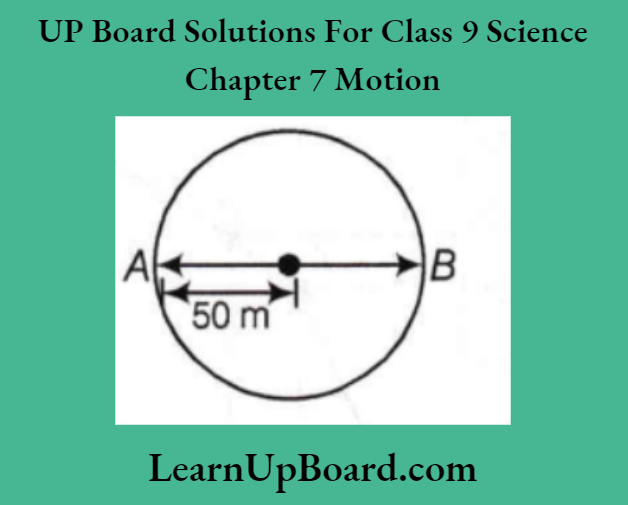
Answer:
So After half the circle, the particle will reach the diametrically opposite point, i.e. from point A to B. Displacement after half circle = AB = r + r = 2r
Question 7. A particle moves 3m North, 4m East and finally 6m South. Calculate the displacement.
Answer:
According to the question,
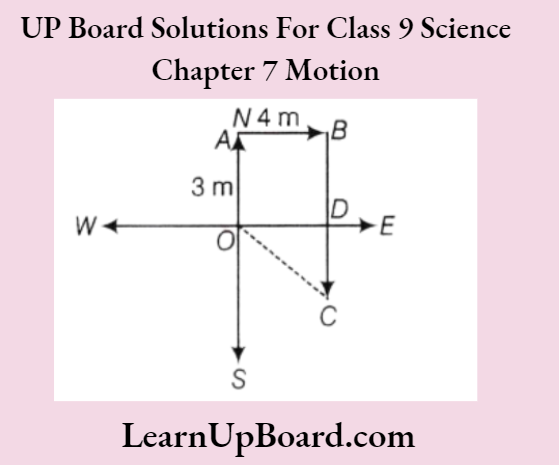
Now, by applying Pythagoras theorem in \(\triangle\) ODC,
|O C| =\(\sqrt{O D^2+D C^2}\)
=\(\sqrt{A B^2+(B C-B D)^2}\)
=\(\sqrt{4^2+(6-3)^2}\)
=\(\sqrt{4^2+3^2}=\sqrt{16+9}=\sqrt{25}=5 \mathrm{~m}\)
Question 8. In which condition, will the magnitude of the displacement be equal to the distance travelled by an object?
Answer:
If an object moves in a straight line from one point to another, then the magnitude of displacement and distance will be equal.
Question 9. Give one condition for the motion of a body to be uniform.
Answer:
The body should travel along a straight line path in one direction.
Question 10. Does the speedometer of a car measure its average speed?
Answer:
No, the speedometer of a car does not measure its average speed. It measures only instantaneous speed.
Question 11. What do you mean by an acceleration of 5 m/s2?
Answer:
Acceleration of 5 m/s²
The velocity of the body increases by 5 m/s after every second.
Question 12. A physical quantity measured is -10 m/s. Is it a speed or a velocity?
Answer:
It is a velocity because velocity can be positive, zero or negative while speed is always positive.
Question 13. A person while travelling with his car found that the magnitude of average velocity was equal to its average speed. Identify the path formed by him.
Answer:
If a person moves in a straight line, then their average velocity will be equal to the average speed.
Question 14. What is the numerical ratio of average velocity to average speed of an object when it is moving along a straight path?
Answer:
The numerical ratio of the average velocity and average speed of an object when it is moving along a straight path is 1: 1.
Question 15. A person standing at A goes to B by following any of the paths 1, 2 and 3. Which path can we use to find the average velocity?
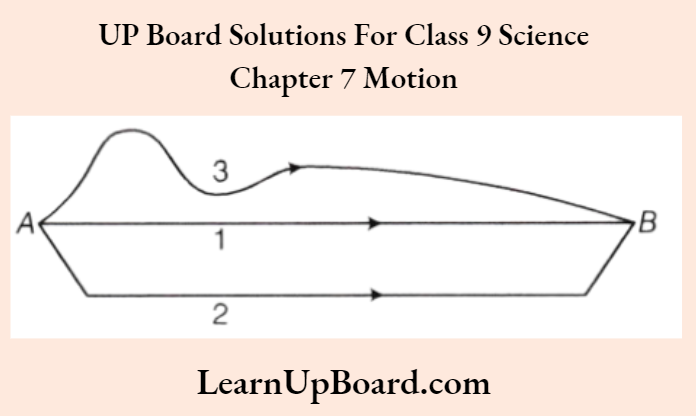
Can a particle be accelerated?
- Is its speed constant?
- Is its velocity constant?
Answer: Path-1
- Yes, a particle moving with constant speed can be accelerated.
- No
Question 16. When is the acceleration taken as negative?
Answer:
Acceleration is taken as negative if it is in the opposite direction of motion of the object.
Question 17. A body accelerates uniformly so that its velocity changes from u to v. What will be its average velocity?
Answer:
The average velocity is \(\frac{u+v}{2}\).
Question 18. What kind of motion of a body is represented by the graphs given below?
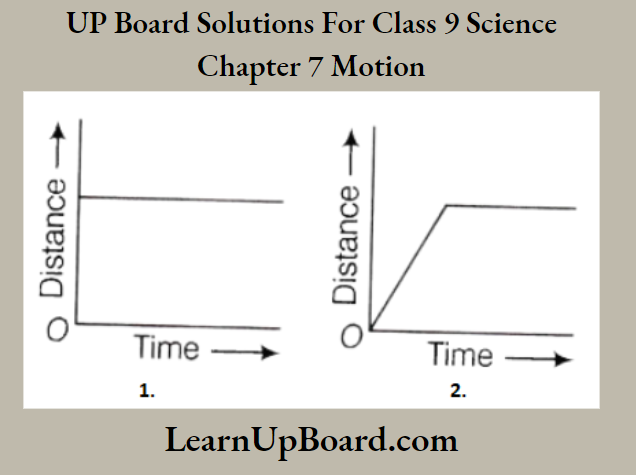
Answer:
- The object is at rest
- Non-uniform motion.
Question 19. The distance-time graph for the motion of Ram and Shyam is shown alongside. Which of them has greater acceleration? Justify your answer.
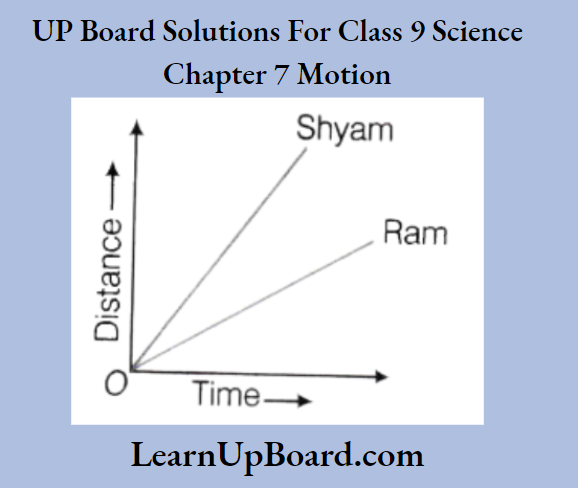
Answer:
Both Ram and Shyam have zero acceleration as they are moving with constant velocity. Since the distance-time graph is a straight line.
Question 20. Figure shows the displacement-time graph of four children A, B, C and D. Which child has the highest velocity?
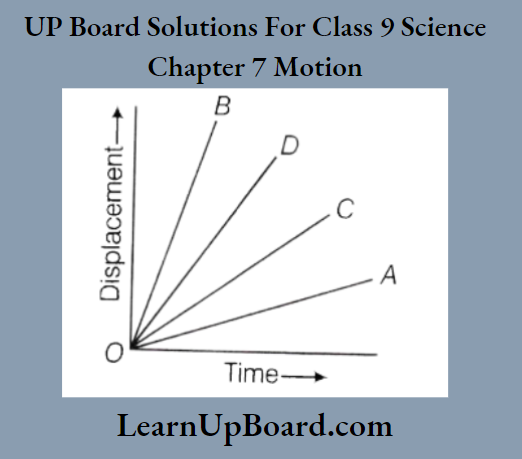
Answer:
As we know, velocity = slope of the displacement-time graph. Here, the slope of child B is greater than all other children. Hence, child B has the highest velocity.
Question 21. From the given v-t graph (see figure), what can be inferred?
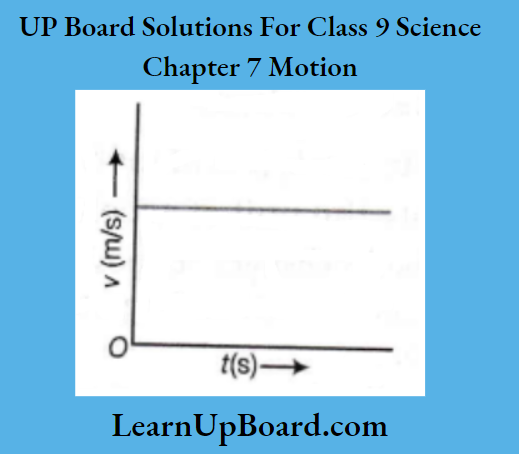
Solution:
From the given v-t graph, it is clear that the velocity of an object does not change with time, i.e. the object is in a uniform motion.
Question 22. How do we measure the magnitude of the displacement from a v-t curve?
Answer:
By measuring the area under the v-t curve along the time axis.
Question 23. Give one example of uniform circular motion.
Answer:
Example of uniform circular motion
A satellite in a circular orbit around the Earth is an example of uniform circular motion.
Question 24. Is the motion of a body uniform or accelerated, if it goes round the sun with constant speed in a circular orbit?
Answer:
In this case, the motion of a body is accelerated as its velocity changes due to the change in direction.
Question 25. Why is the motion of a circulating fan non-uniform?
Answer:
The motion of a circular fan is non-uniform because the direction of motion changes at every point.
Question 26. Give an expression for the speed of an athlete if he takes time t to go around a circular track, of radius r.
Answer:
v=\(\frac{2 \pi r}{t}\)
Question 27. Find the angular velocity of a satellite which revolves in a circular orbit of radius 35000 km and completes one round in 12 h.
Answer:
Angular velocity =\(\frac{\text { Angle subtended at centre }}{\text { Time taken }}\)
= \(\frac{2 \pi}{12}\)
= \(\frac{\pi}{6} \mathrm{rad} / \mathrm{h}\)
Class 9 Science Chapter 7 Motion Short Answer Type Questions
Question 1. (1) What is motion?
(2) State the types of motion.
(3) Write the unit of acceleration.
Answer:
Motion:
(1) If a body changes its position concerning time and its surroundings, then it is said to be in motion.
Types of motion:
(2) Generally, there are two types of motion:
(a) Uniform motion (b) Non-uniform motion
The unit of acceleration:
(3) The SI unit of acceleration is m/s2.
Question 2. A cow and a bird both A 15 m B travelled from point A to point B. The cow travelled in a straight line but the bird travelled along the curved path as shown alongside:
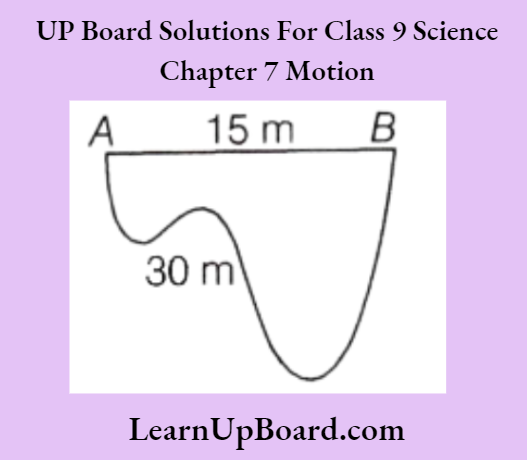
- What is the distance travelled by the cow?
- What is the distance travelled by the bird?
- Which one of them has more displacement?
Answer:
- Distance travelled by the cow = 15 m
- Distance travelled by the bird = 30 m
- Displacement of the cow = 15 m
Displacement of the bird = 15 m
So, cows and birds have the same displacement.
Question 3. Give an example of a body which may appear to be moving for one person and stationary for the other.
Answer:
For the passengers in a moving bus, the trees, buildings as well as the people on the roadside appear to be moving backwards. Similarly, a person standing on the roadside observes that the bus (along with its passengers) is moving in a forward direction.
But at the same time, each passenger in a moving bus or train observes that his fellow passengers are at rest. Thus, we can tell that motion is relative.
Question 4. How can we describe the location of an object?
Answer:
To describe the location of an object we need to specify a reference point called origin, e.g. suppose that a library in a city is 2 km North of railway station. We have specified the position of the library with respect to the railway station, i.e. in this case, the railway station acts as the reference point.
Question 5. Differentiate between distance and displacement.
Answer:
Differences between distance and displacement are as given below:
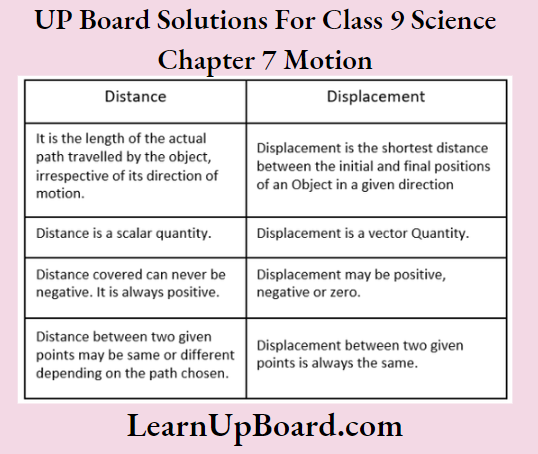
Question 6. Express average velocity when the velocity of a body changes at a non-uniform rate and a uniform rate.
Answer:
When the velocity of a body changes at a non-uniform rate, then its average velocity is calculated by dividing the net displacement covered by the total time taken.
Average velocity =\(\frac{\text { Net displacement }}{\text { Total time taken }}\)
In case, the velocity of a body changes at a uniform rate, the average velocity is given by the arithmetic mean of initial velocity and final velocity for a given period of time, i.e.
Average velocity= \(\frac{\text { Initial velocity }+ \text { Final velocity }}{2}\)
Question 7. Give one example each of type of motion when
- acceleration is in the direction of motion.
- acceleration is against the direction of motion.
Answer:
- A train starts moving from a station.
- Brakes applied to a moving car.
Question 8. Draw a velocity versus time graph of a stone thrown vertically upwards and then coming downwards after attaining the maximum height.
Answer:
When a stone is thrown vertically upwards, then it has some initial velocity (u). As the stone goes up its velocity decreases (since it is moving against gravity) and at the highest point, i.e. maximum height,) its velocity becomes zero.
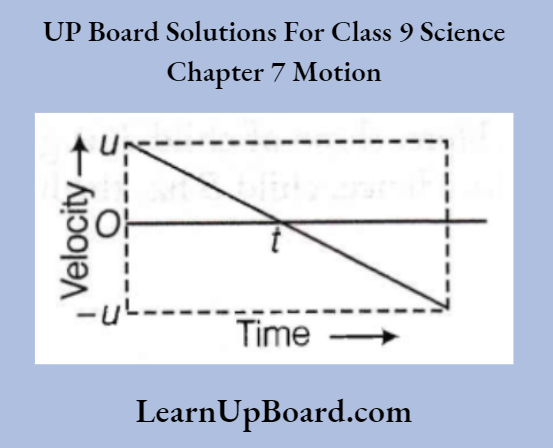
Let the stone take time the t second to reach the highest point. After that stone begins to fall (with zero initial velocity) and its velocity goes on increasing (since it is moving with gravity) and it reaches its initial point of projection with the velocity (—u) at the same time (with which it was thrown). So,

Question 9. A biker rides 700 m north, 300 m east, 400 m north, 600 m west, 1200 m south, 300 m east and finally 100 m north. Draw the path of motion of the biker. What distance did he cover? What was his displacement?
Answer:
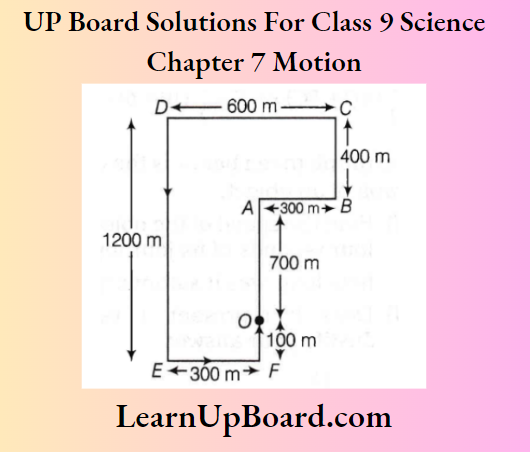
Given
A biker rides 700 m north, 300 m east, 400 m north, 600 m west, 1200 m south, 300 m east and finally 100 m north.
(2) Distance travelled by the biker
= OA + AB + BC + CD + DE + EF + FO = 700 + 300 + 400 +600 + 1200 + 300 + 100 = 3600 m
(3) Displacement of the biker = 0.
Question 10. An object P is moving with a constant velocity for 5 min. Another object O is moving with changing velocity for 5 min. Out of these two objects, which one has acceleration? Explain.
Answer:
Given
An object P is moving with a constant velocity for 5 min. Another object O is moving with changing velocity for 5 min.
Acceleration =\(\frac{\text { Change in velocity }}{\text { Time taken }}\)
Since the velocity of object P is not changing or the change in velocity of the object is gro, therefore object-t Phas no acceleration. On the other hand, there is i change in velocity of the object Q, so it has acceleration.
Question 11. A car covers the first 50 km at a uniform velocity of 45 km/h and the next 50 km at 90 km/h. Find the average velocity of the car.
Answer:
Given
A car covers the first 50 km at a uniform velocity of 45 km/h and the next 50 km at 90 km/h.
Total displacement = 50 + 50 = 100 km
Total time =\(\frac{50}{45}+\frac{50}{90} =50\left(\frac{1}{30}\right)=\frac{5}{3} \mathrm{~h}\)
∴ \({\left[\text { Time }=\frac{\text { Displacement }}{\text { Velocity }}\right] }\)
Average velocity =\(\frac{\text { Total displacement }}{\text { Time taken }}=\frac{100}{5 / 3}\)
= 60 km/h
The average velocity of the car is 60 km/h.
Question 12. A girl moves at a speed of 6 km/h for two hours and with a speed of 4 km/h for the next three hours. Find the average speed of the girl and the total distance moved.
Answer:
Given
A girl moves at a speed of 6 km/h for two hours and with a speed of 4 km/h for the next three hours.
Here, \(v_1=6 \mathrm{~km} / \mathrm{h}, t_1=2 \mathrm{~h}, v_2=4 \mathrm{~km} / \mathrm{h}, t_2=3 \mathrm{~h}\)
Total distance =\(v_1 t_1+v_2 t_2=6 \times 2+4 \times 3=24 \mathrm{~km}\)
Average speed =\(\frac{\text { Total distance }}{\text { Total time }}\)
= \(\frac{24}{2+3}=4.8 \mathrm{~km} / \mathrm{h}\)
Question 13. A person travelling in a bus noted the timings and the corresponding distances as indicated on the km stones.
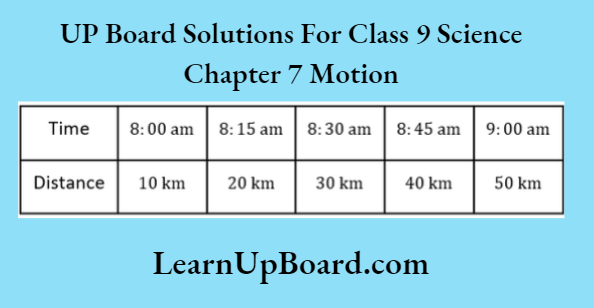
- Name this type of table.
- What conclusion do you draw from this data?
Answer:
- It is a distance-time table.
- According to the given table, we conclude that the given motion is uniform motion as in every 15 the body covers 10 km.
Question 14. Represent the given data graphically.
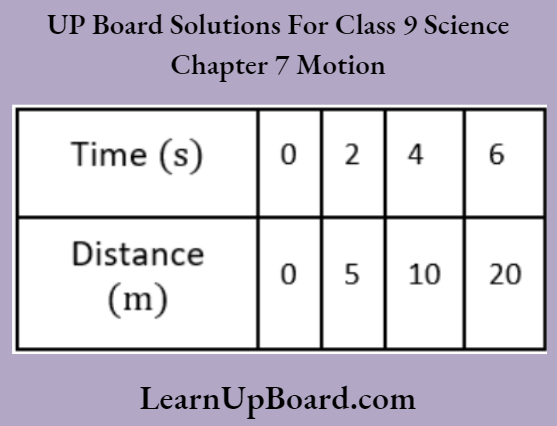
Answer:
From the given distance-time table, the graph can be drawn as
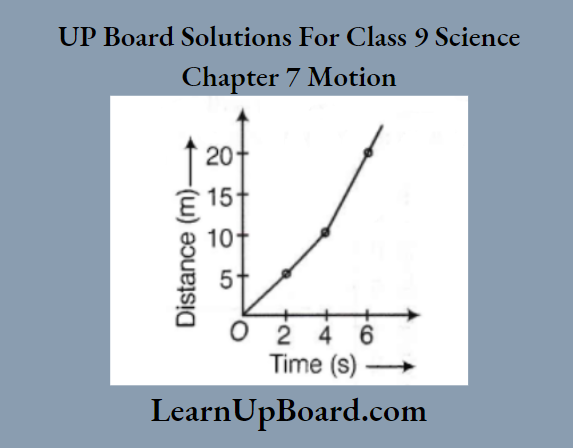
Question 15. Two trains A and B start moving at the same time. The distances travelled by them in given internals of time are shown below. State which train has uniform motion and which train has non-uniform motion.
Answer:
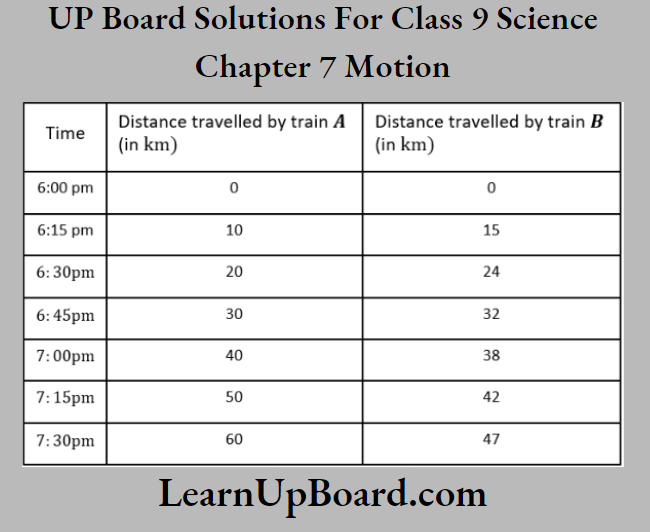
Since, train A travels equal distances in equal intervals of time, i.e. every 15 min, the motion of train A is uniform motion.
On the other hand, train B travels unequal distances in equal intervals of time, i.e. every 15 min, so the motion of train B is non-uniform motion.
Question 16. Make a velocity-time graph from the following displacement-time graph:
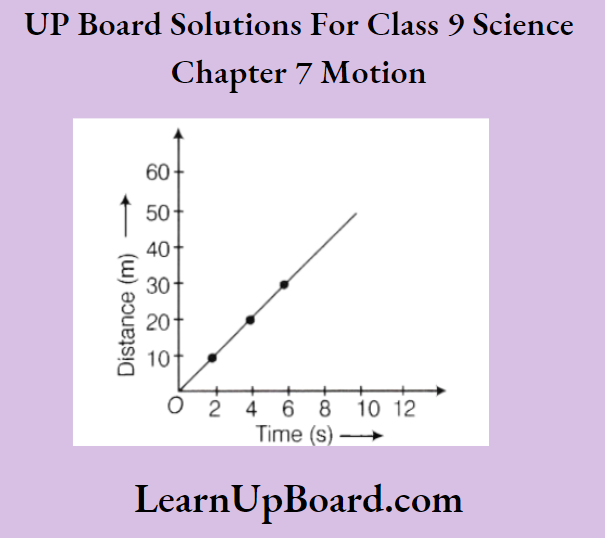
Answer:
From the graph,
velocity after 2 \(\mathrm{~s}=\frac{10}{2}=5 \mathrm{~m} / \mathrm{s}\)
Velocity after 4 \(\mathrm{~s}=\frac{20}{4}=5 \mathrm{~m} / \mathrm{s}\) and velocity after 6 \(\mathrm{~s}=\frac{30}{6}=5 \mathrm{~m} / \mathrm{s}\)
For Example. Velocity is constant, acceleration = 0
So, the velocity-time graph will be a straight line parallel to the time axis as shown below:
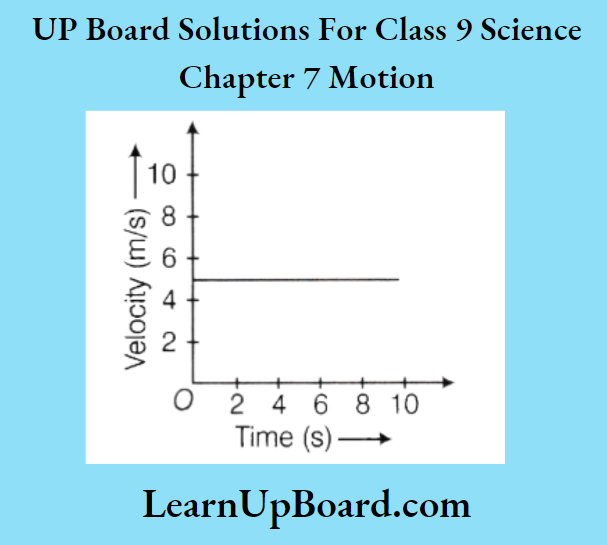
Question 17. Find the displacement of a body whose velocity-time graph is shown as:
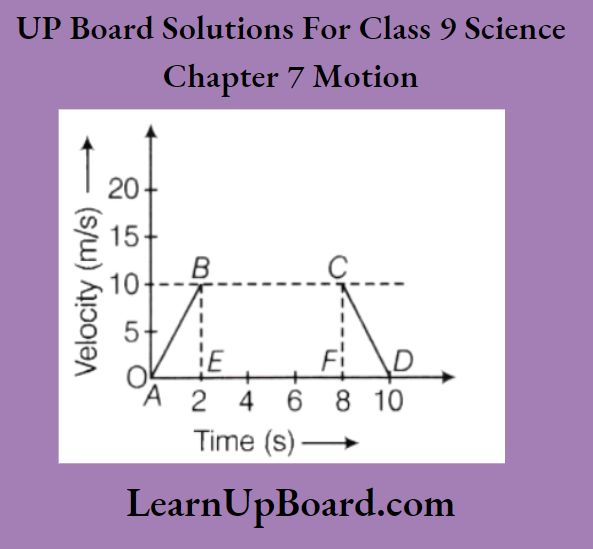
Answer:
Displacement = Area under v-t curve (i.e. the area of trapezium ABCD )
= \(\frac{1}{2}(\text { sum of parallel sides }) \times \text { height }\)
= \(\frac{1}{2}(A D+B C) \times C F=\frac{1}{2}(10+6) \times 10=80 \mathrm{~m}\)
Question 18. The graph given below is the distance-time graph of an object.
- Find the speed of the object during the first four seconds of its journey and how long was it stationary.
- Does it represent a real situation? Justify your answer.
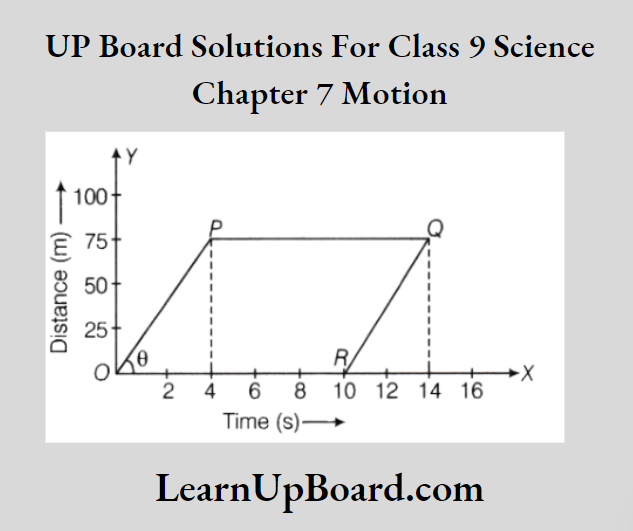
Answer:
(1) Speed during first 4s = Slope of OP
⇒ \(\tan \theta=\frac{75}{4}=18.75 \mathrm{~m} / \mathrm{s}\)
From 4 s to 14 s, the distance does not change with time, so it is stationary for 10 s.
(2) No, it is not a real situation because distance travelled cannot decrease with time. Moreover, time cannot flow backwards as shown by the QR part of the graph.
Question 19. The velocity-time graph (see figure) shows the motion of a cyclist. Find
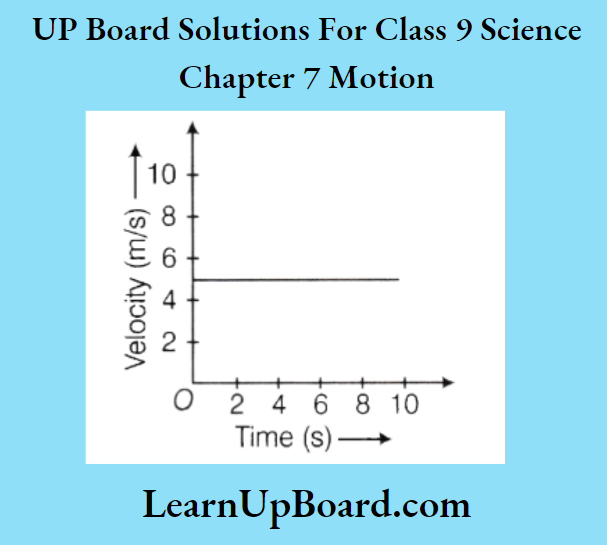
- its acceleration,
- its velocity and the distance covered by the cyclist in 15 seconds.
Answer:
- From the graph, it is clear that velocity does not change with time, i.e. acceleration is zero.
- Again from the graph, we can see that there is no change in the velocity with time, so velocity after 15 seconds will remain the same as 20 m/s.
Distance covered in 15 s = Velocity x Time = 20×15 = 300 m
Question 20. Find the total displacement of the body from the following graph
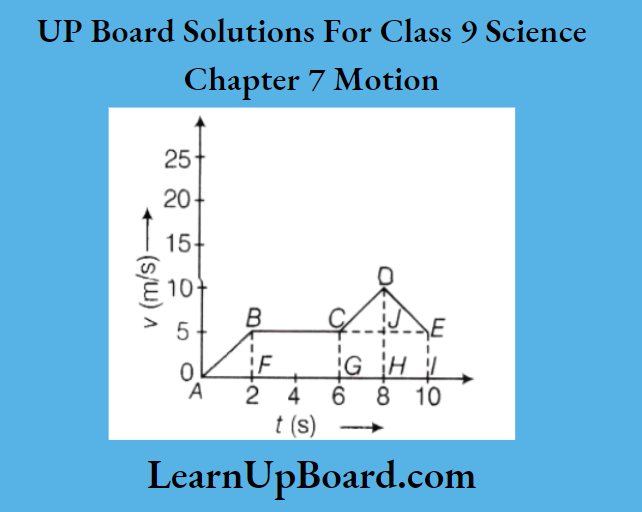
Answer:
Total displacement = Sum of areas of (\(\triangle\) A B F+ Rectangle BCGF + \(\triangle\) CDE +{ Rectangle CEIG)
=\([\frac{1}{2}(A F \times F B)+(B C \times C G)\).
⇒ \(\left.\quad+\frac{1}{2}(C E \times D J)+(C E \times E I)\right]\)
= \(\left[\frac{1}{2}(2 \times 5)+(4 \times 5)+\frac{1}{2}(4 \times 5)+(5 \times 4)\right]\)
=55 m
Question 21. The speed-time graphs of the two cars are represented by P and Q as shown below:
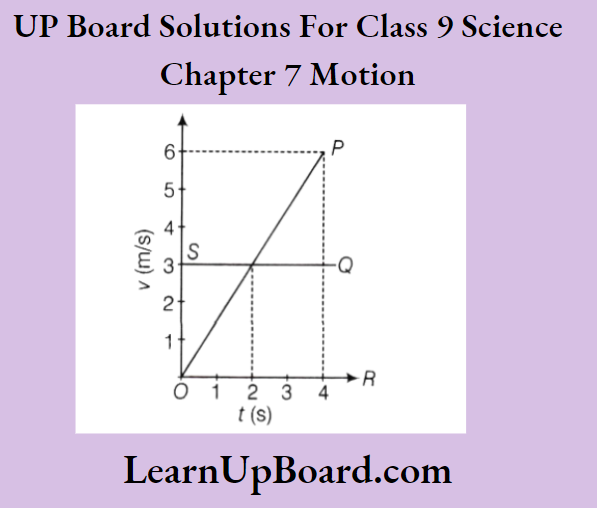
- Find the difference in the distance travelled by the two cars (in m) after 4 s.
- Do they ever move at the same speed? If, so when?
Answer:
(1) Total distance travelled by P (area of A POR)
= 1/2 x4x 62
= 12 m
Total distance travelled by Q (area of RQSO)
= 4×3 = 12m
Difference in the distance = 12-12=0
(2) Yes, they move with the same velocity equal to 3 m/s at time 2 s. It can be determined, by viewing the intersection point of two v-t graphs.
Question 22. Study the v-t table and answer the following:
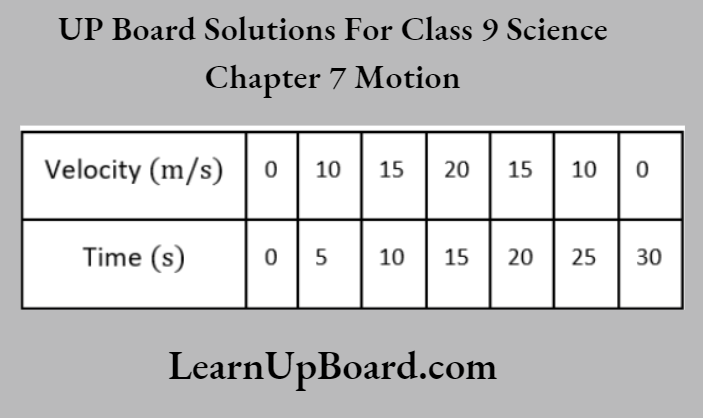
- What is the value of an in 0 to 15 s?
- Predict the nature of acceleration in different parts of the graph.
Answer:
(1) a =\(\frac{\text { Change in velocity }}{\text { Time interval }}\)
=\(\frac{20-0}{15-0}=\frac{20}{15}=\frac{4}{3}\)
=1.33 \(\mathrm{~m} / \mathrm{s}^2\)
(2) The body is in uniform motion from 0 to 15 s, then non-uniform related motion from 15 s to 30 s. Here, OA = uniformly accelerated AB, BC, CD = uniformly related.
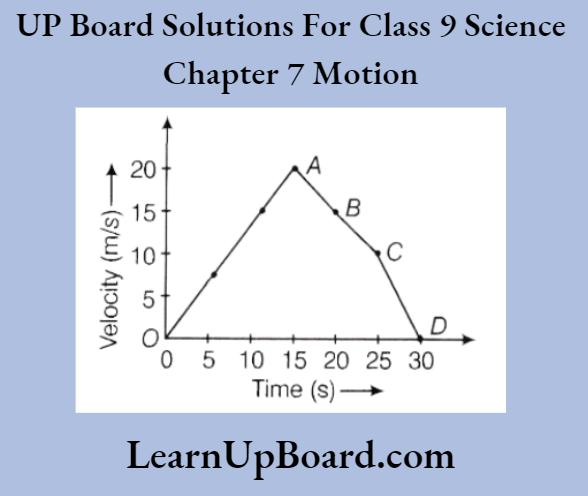
Question 23. What is the difference between uniform motion in a straight line and circular motion?
Answer:
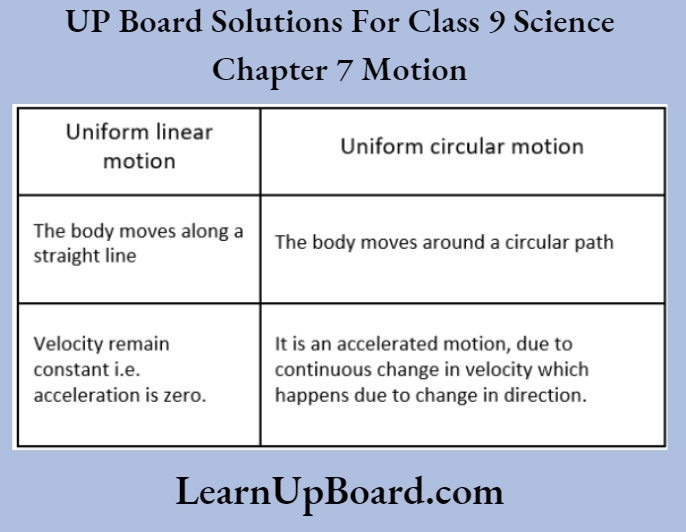
Question 24. Study the following distance-time graph and compare the velocity of the two objects
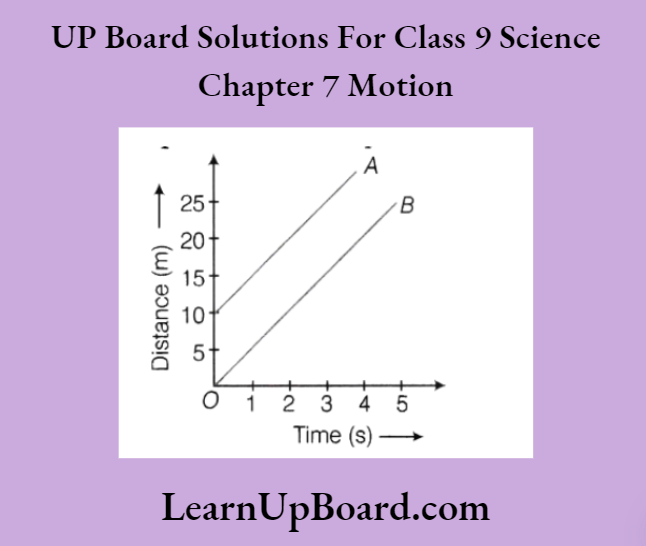
Answer:
Since A and B have parallel slopes for distance-time graphs, their velocities are equal. However, A starts from the 10 m mark and B starts from the origin, (i.e. A is ahead of B by 10 m)
Question 25. What do the graphs (1) and (2) shown here indicate?
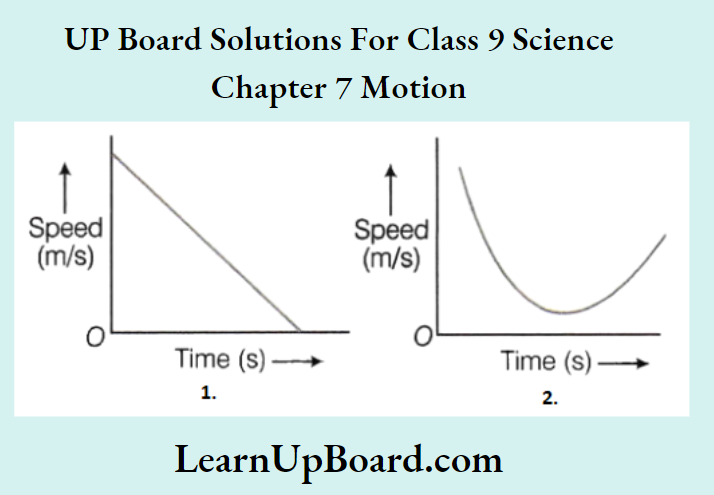
Answer:
Graph (1) indicates that a body has a certain initial speed and then its speed decreases to zero.
Graph (2) shows that a body first retards and then accelerates non-uniformly.
Question 26. Can an object be accelerated, if it is moving with constant speed? Justify your answer with an example.
Or Can a body have a constant speed and still be accelerating? Give an example.
Or Explain, how is it possible for an object to move with a constant speed but with uniform acceleration.
Answer:
An object moving with a constant speed can be accelerated, if its direction of motion changes, For Example. An object moving with a constant speed in a circular path has acceleration because its direction of motion changes continuously. Its acceleration is always directed toward the centre of the circular path.
Question 27. A bridge is 500 m long. A 100 m long train crosses the bridge at a speed of 30 m/s. Find the time taken by train to cross it.
Answer:
Given
A bridge is 500 m long. A 100 m long train crosses the bridge at a speed of 30 m/s.
Total length of path covered by train = 500 + 100 =600 m
Speed of train = 30 m/s
Time taken by train to cover the bridge
Time taken by train to cover the bridge
= \(\frac{\text { Distance }}{\text { Speed }}=\frac{600}{30}=20 \mathrm{~s}\)
Question 28. When two bodies move uniformly towards each other, then the distance between them decreases by 8 m/s. If both the bodies move in the same direction at the same speeds, then the distance between them increases by 4 m/s. What are the speeds of two bodies?
Answer:
Given
When two bodies move uniformly towards each other, then the distance between them decreases by 8 m/s. If both the bodies move in the same direction at the same speeds, then the distance between them increases by 4 m/s.
Let u and v be the speeds of two bodies. According to the question, when two bodies move towards each other the distance between them decreases by u + v = 8 and when they are moving in the same direction,
then the distance between them increased by u – v = 4
Solving the above equations, we get 2u=12 ⇒ u — G m/s
and v =8 —u =8 -6 = 2 m/s The speed of two bodies are 6 m/s and 2 m/s.
Question 29. A fan rotates at 100 rpm. Find its angular velocity and linear velocity, if the tip of its blades is 0.20 m away from the axis of rotation.
Answer:
Given, angular velocity, \(\omega\)=100 rpm=100 \(\times \frac{2 \pi}{60}\)
= \(\frac{10 \pi}{3} \mathrm{rad} / \mathrm{s}\)
Radius, r=0.20 \(\mathrm{~m}\)
Linear velocity =\(\text { Radius } \times \text { Angular velocity }\)
v=r \(\omega\)
Linear velocity =0.20 \(\times \frac{10 \pi}{3}\)
= \(\frac{2 \pi}{3} \mathrm{~m} / \mathrm{s}\)
Question 30. An object is moving with a uniform speed in a circle of radius r. Calculate the distance and displacement,
- when it completes half the circle,
- when it completes full circle,
- what type of motion does the object possess?
Answer:
(1) When an object completes half the circle, then the distance travelled by an object
= \(\frac{1}{2} \times \text { circumference of a circle }\)
= \(\frac{1}{2} \times 2 \pi r=\pi r\)
(2) When an object completes a full circle, then the distance travelled by an object = \(2 \pi\) r
Displacement travelled by an object = 0 [since initial and final positions are the same]
(3) The direction of motion of an object changes continuously in the circle, hence its velocity changes and its motion is accelerated motion.
Question 31. An athlete runs on a circular track of a radius of 50 m from the starting point A with a constant speed. It takes 50 seconds for him to reach point B which is at the other end of the diameter drawn from A. Calculate the distance covered, displacement and speed.
Answer:
Given
An athlete runs on a circular track of a radius of 50 m from the starting point A with a constant speed. It takes 50 seconds for him to reach point B which is at the other end of the diameter drawn from A.
Distance covered by the athlete =\(\pi r\)
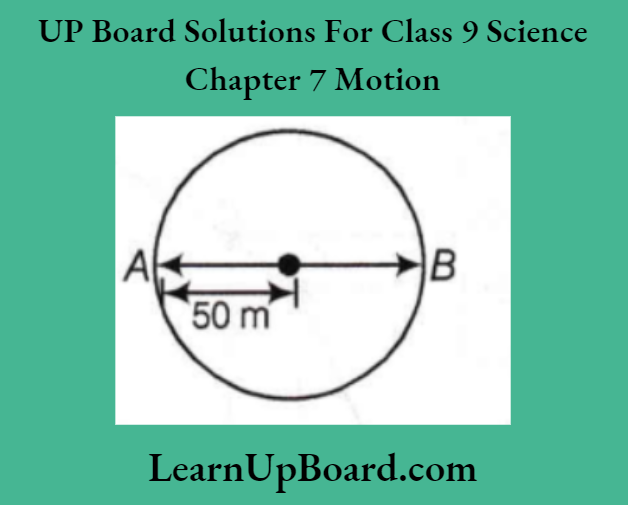
= \(\frac{22}{7} \times 50=157.14 \mathrm{~m}\)
Displacement of the athlete
=2 r=2 \(\times 50=100 \mathrm{~m}\)
The speed of the athlete is given by
= \(\frac{\text { Distance }}{\text { Time }}\)
= \(\frac{\pi r}{50}\)
= \(\frac{22}{7} \times \frac{50}{50}=3.14 \mathrm{~m} / \mathrm{s}\)
Class 9 Science Chapter 7 Motion Long Answer Type Questions
Question 1. Give one example of each of the following situations:
- Uniformly accelerated motion.
- Motion with uniform retardation.
- Accelerated motion with a uniform magnitude of velocity.
- Motion in a direction with acceleration in a perpendicular direction.
- Motion in which the v-t graph is a horizontal line parallel to the X-axis.
Answer:
- An object dropped down from a height towards the surface of the earth.
- The object thrown up with a velocity retards uniformly.
- Uniform circular motion, say planetary motion.
- A bullet fired horizontally from a rifle, has acceleration in a downward direction (due to gravity).
- A car moving with uniform velocity along a straight line
Question 2. The position-time graphs of two objects A and B in three different situations for a particular duration are shown below:
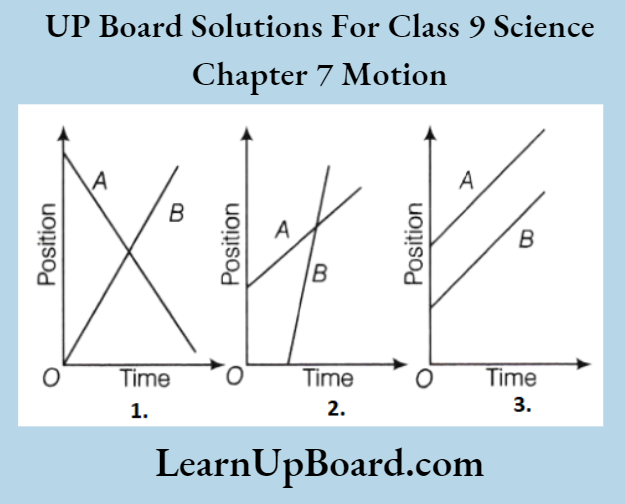
- In which situation they are moving in opposite directions?
- Is the velocity of object A positive or negative in the situation (2)?
- Are they crossing each other in any situation (s)? If so, why?In which situation the distance between them will remain the same?
Answer:
- In graph (3), the distance between them will be the same.
- In the graph (1), they are moving in opposite directions.
- The velocity of object A is positive in situation (1) because the slope of the s-t graph is positive.
- Yes, in situations (1) and (2) they are crossing each other because in these two cases, the s-t graph of A and B intersect each other.
Question 3. On a 100 km track, a train travels the first 30 km at a uniform speed of 30 km/h. How fast must the train travel the next 70 km, so as to average 40 km/h for the entire trip?
Answer:
Given
On a 100 km track, a train travels the first 30 km at a uniform speed of 30 km/h.
Total time, t=\(t_1+t_2=\frac{30 \mathrm{~km}}{30 \mathrm{~km} / \mathrm{h}}+\frac{70 \mathrm{~km}}{x(\text { say })}\)
t=1+\(\frac{70}{x}=\left(\frac{x+70}{x}\right) \mathrm{h}\)
Now, average speed, v=\(\frac{s}{t}=40 \mathrm{~km} / \mathrm{h}\)
According to question, \(\frac{100}{\underline{x+70}}=40\)
10=4\(\left(\frac{x+70}{x}\right)^x\)
10 x=4 x+280
6 x=280
x=46.67 \(\mathrm{~km} / \mathrm{h}\)
The speed for the next 70 km to maintain an average of 40 km/h is 46.67 km/h.
Question 4. Study the speed-time graph of a body given here and answer the following questions:

- What type of motion is represented by OA?
- What type of motion is represented by AB?
- What type of motion is represented by BC?
- Find out the acceleration of the body.
- Calculate the retardation of the body.
- Find out the distance travelled by the body from A to B.
Answer:
1. OA is a straight line graph between speed and time and it is sloping upward from O to A. Here, OA represents uniform acceleration.
2. AB is a straight line graph between speed and time which is parallel to the time axis (X-axis). So, AB represents uniform speed. There is no acceleration from A to B.
3. BC is a straight line graph between speed and time which is sloping downwards from B to C. Therefore, BC represents uniform retardation or negative acceleration.
4. Acceleration of the body as we see from graph line OA represents it.
So, the slope of the velocity-time graph OA will give the acceleration of the body.
Thus, acceleration = slope of line OA=\(\frac{A D}{O D}\)
We have, AD=6 \(\mathrm{~m} / \mathrm{s} and OD=4 \mathrm{~s}\)
So, acceleration =\(\frac{6 \mathrm{~m} / \mathrm{s}}{4 \mathrm{~s}}=1.5 \mathrm{~m} / \mathrm{s}^2\)
5. The slope of line graph BC represents the retardation of the body.
So, retardation = slope of line BC = \(\frac{B E}{E C}\)
We have, BE= 6 \(\mathrm{~m} / \mathrm{s}\),
E C=16-10=6 \(\mathrm{~s}\)
Retardation =\(\frac{6 \mathrm{~m} / \mathrm{s}}{6 \mathrm{~s}}=1 \mathrm{~m} / \mathrm{s}^2\)
6. The distance travelled by the body is equal to the area enclosed between the speed-time graph and the time axis.
Distance travelled from A area under the line AB and the time axis = area of rectangle DABE — DA x DE.
Here, DA = 6 m/s and DE = 10 — 4 = 6 s Distance travelled from A to B=6×6 = 36 m
Question 5. The v-t graph of an object is shown below:
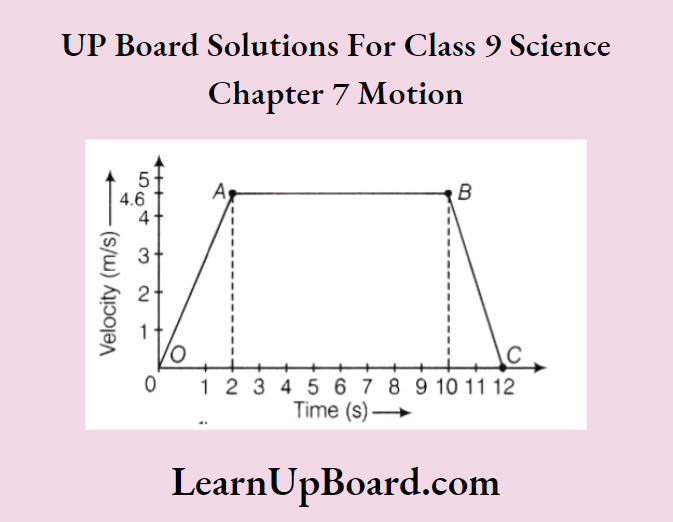
- Identify the type of motion by lines OA and BC.
- Velocity at t = 8s.
- Calculate acceleration
- between 3rd and 10th second.
- last 2s.
Answer:
1. OA represents uniformly accelerated motion, and BC represents uniformly retarted motion.
2. At t =8 s, the velocity of the object is 4.6 m/s.
3. (1) Between 3rd and 10th second, a – 0.
(2) During last 2s,
Acceleration, a=\(\frac{\text { change in velocity }}{\text { time interval }}\)
=\(\frac{0-4.6}{12-10}=\frac{-4.6}{2}=-\frac{4.6}{2}=-2.3 \mathrm{~m} / \mathrm{s}^2\)
Question 6. An insect moves along a circular path radius of 10 cm with a constant speed. It takes 1 minute to move from a point on the path to the diametrically opposite point, find
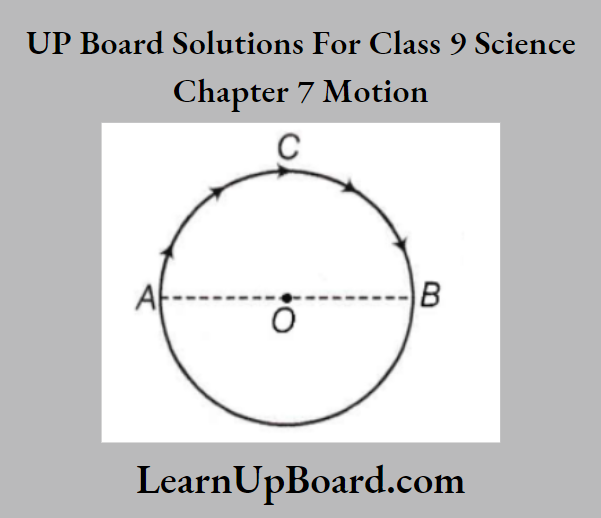
- the distance covered,
- the speed,
- the displacement and
- the average velocity. Suppose the insect was at A initially and it moves along ACB to reach the diametrically opposite point B in 1 min.
Answer:
- The distance moved in 1 min = nr = 3.14×10 =31.4 cm
- Speed =\(\frac{\text { Distance }}{\text { Time }}=\frac{31.4}{1}=31.4 \mathrm{~cm} / \mathrm{min}\)
- Displacement, AB = 2r = 2 x 10 = 20cm
- Average velocity,
- \(v_{\mathrm{av}} =\frac{\text { Displacement }}{\text { Time }}\)
- =\(\frac{20 \mathrm{~cm}}{1 \mathrm{~min}}=20 \mathrm{~cm} / \mathrm{min}\)
Question 7. The driver of train A travelling at a speed of 54 km/h applies brakes and retards the train uniformly. The train stops in 5 s. Another train B is travelling on the parallel with a speed of 36 km/h.
Its driver applies the brakes and the train retards uniformly, train B stops in 10 s. Plot speed-time graphs for both trains on the same axis. Which of the trains travelled farther after the brakes were applied?
Answer:
For train A, the initial velocity,
u=54 \(\mathrm{~km} / \mathrm{h}=54 \times \frac{5}{18}=15 \mathrm{~m} / \mathrm{s}\)
Final velocity, v=0 and time, t=5 s
For train B, u=36 \(\mathrm{~km} / \mathrm{h}=36 \times \frac{5}{18}=10 \mathrm{~m} / \mathrm{s}\)
⇒ \(\nu\)=0, t=10 \(\mathrm{~s}\)
Speed-time graphs for trains A and B are shown
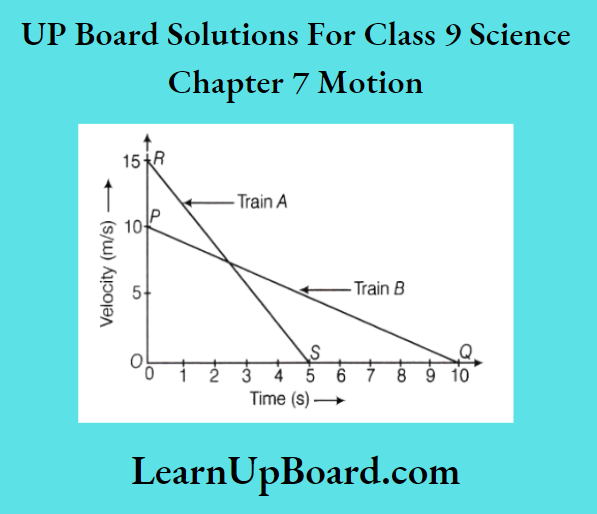
Distance travelled by train A= Area under straight line graph
RS = area of \(\triangle\) ORS
= \(\frac{1}{2} \times O R \times O S\)
= \(\frac{1}{2} \times 15 \times\) 5=37.5 m
Distance travelled by train B Area under PQ
= \(\frac{1}{2} \times O P \times OQ \)
= \(\frac{1}{2} \times 10 \times 10=50 \mathrm{~m}\)
Distance travelled by train B is more than train A.
